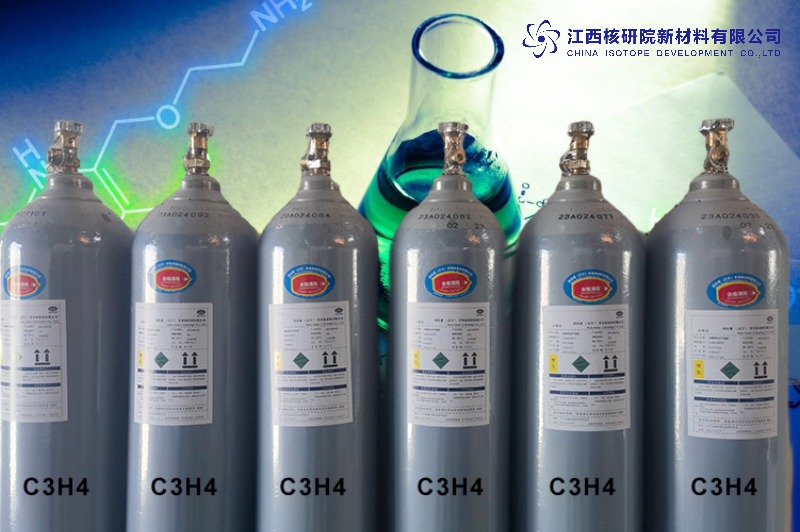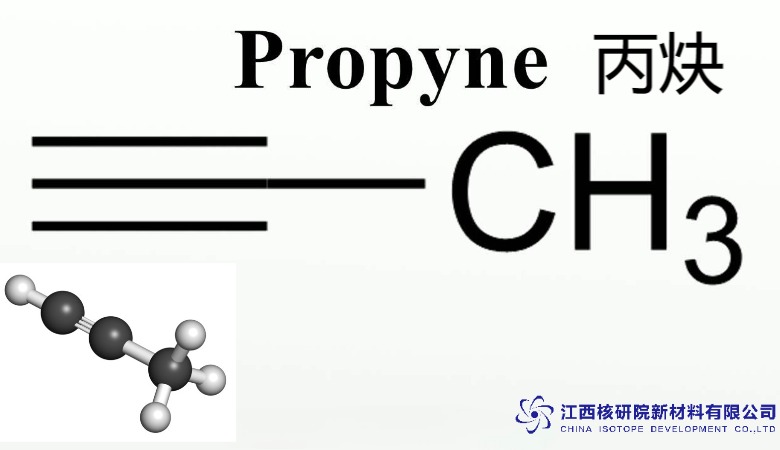Exploring Propyne Uses: From Rocket Fuel to Organic Synthesis Breakthroughs
BY STEVEN, Published August 17, 2025
Propyne, also known as methylacetylene (C₃H₄), is a versatile alkyne hydrocarbon that has carved a niche in both industrial applications and cutting-edge scientific research. Its unique chemical structure, featuring a carbon-carbon triple bond, endows it with exceptional reactivity and energy content, making it a critical specialty gas in fields as diverse as welding, organic synthesis, rocket propulsion, and astrochemistry. As a nuclear research expert with decades of experience in specialty gases and hydrocarbons, I present a comprehensive exploration of propyne’s applications, properties, and practical considerations. This article delves into how propyne drives innovation, offering insights for researchers, engineers, and industry professionals while maintaining accessibility and SEO optimization through natural keyword integration and varied formatting.
1. The Fundamentals of Propyne: A High-Energy Alkyne
Propyne, with the molecular formula C₃H₄, is a three-carbon alkyne characterized by a triple bond between the second and third carbon atoms (CH₃C≡CH). This triple bond, comprising one sigma bond and two pi bonds, is the source of propyne’s high reactivity and energy density, distinguishing it from other hydrocarbons like alkanes or alkenes. As a colorless gas with a sweet odor, propyne’s physical properties—such as its boiling point of -23.2°C and melting point of -102.7°C—make it suitable for applications requiring a volatile yet manageable gas.
The molecular weight of propyne is 40.06 g/mol, and its low solubility in water (3,640 mg/L at 20°C) contrasts with its high solubility in organic solvents like ethanol and chloroform, enhancing its utility in chemical synthesis. Propyne’s flammability, with explosive limits of 1.7% to 11.7% in air, underscores its high energy content, which is harnessed in applications like welding and propulsion. Its ability to be safely liquefied, unlike acetylene, makes it a practical choice for industrial storage and transport, positioning propyne as a cornerstone in the specialty gas market.
2. Propyne’s Chemical Structure: The Triple Bond Advantage
The structure of propyne is defined by its linear arrangement around the carbon-carbon triple bond. The molecular configuration, H₃C-C≡CH, includes:
- Carbon 1 (CH₃): A methyl group bonded to three hydrogens and the second carbon via a single bond.
- Carbon 2 (C≡): Triple-bonded to the third carbon and single-bonded to the first carbon, contributing to the molecule’s rigidity.
- Carbon 3 (≡CH): Triple-bonded to the second carbon and single-bonded to a hydrogen atom, known as the alkynyl hydrogen.
This structure results in a bond angle of approximately 180° around the triple-bonded carbons, giving propyne a linear geometry in that region. The triple bond’s high electron density enables addition reactions with electrophiles or nucleophiles, making propyne a reactive intermediate in organic synthesis. For instance, deprotonation of the alkynyl hydrogen with a strong base like n-butyllithium yields propynyllithium, a versatile nucleophile for constructing complex molecules.
In analytical chemistry, propyne’s spectral properties aid in its identification. In nuclear magnetic resonance (NMR) spectroscopy, it exhibits a singlet at approximately 1.8 ppm in deuteriochloroform due to overlapping signals from its propargylic and alkynyl protons. Its infrared spectrum shows a characteristic C≡C stretch at 2,135 cm⁻¹, which is critical for detecting propyne in astrophysical studies.
3. Diverse Applications of Propyne
Propyne’s unique combination of reactivity, energy content, and condensability enables a wide range of applications across industry and research. Below are the key areas where propyne is making a significant impact:
- Welding and Metalworking: Propyne is a primary component of MAPP gas (Methylacetylene-Propadiene Propane), a fuel mixture used in oxy-fuel welding and cutting. Its high flame temperature, reaching up to 2,900°C in oxygen, makes it ideal for brazing, soldering, and cutting metals. Propyne’s ability to be safely condensed reduces the risk of explosive decomposition compared to acetylene, enhancing safety in industrial settings.
- Organic Synthesis: Propyne serves as a three-carbon building block in organic chemistry. Its alkynyl hydrogen can be deprotonated to form propynyllithium, which reacts with carbonyl compounds to produce alcohols, esters, and other molecules. Propyne is a key intermediate in synthesizing alkylated hydroquinones for vitamin E production and other pharmaceuticals. Its affordability, when sourced from MAPP gas, makes it a cost-effective reagent for large-scale synthesis.
- Rocket Propulsion: Propyne is gaining attention as a liquid rocket propellant, particularly in European aerospace research. When combined with liquid oxygen, it offers a specific impulse of approximately 370 seconds, comparable to traditional propellants like monomethylhydrazine (MMH). Its moderate boiling point (-23.2°C) and high density (0.6070 g/cm³ as a liquid) simplify storage compared to cryogenic fuels, making it a less toxic alternative for space missions.
- Astrochemistry: Propyne has been detected in interstellar clouds, such as the Sgr B2 molecular cloud, and in the atmospheres of gas giants like Jupiter, Saturn, Uranus, and Neptune. Its presence provides clues about the formation of polycyclic aromatic hydrocarbons (PAHs), which are precursors to complex organic molecules in space. Propyne’s spectral signatures, observed via infrared and radio astronomy, are critical for studying molecular evolution in the cosmos.
- Material Science: Propyne is used in the production of synthetic rubber, resins, and advanced polymers. Its reactivity in polymerization reactions supports the development of high-performance materials for coatings, adhesives, and composites, contributing to innovations in material science.
4. Technical Advantages of Propyne
Propyne’s properties confer several technical advantages that make it a preferred choice in specific applications:
- High Reactivity: The triple bond enables propyne to participate in diverse chemical reactions, from addition to nucleophilic substitutions, enhancing its utility in synthesis.
- Condensability: Propyne can be safely liquefied and stored under pressure, reducing safety risks compared to acetylene in industrial applications.
- High Energy Content: Its heat of combustion (1,937 kJ/mol) supports its use as a high-performance fuel in welding and propulsion systems.
- Spectral Utility: Propyne’s distinct NMR and infrared signatures facilitate precise identification in analytical and astrophysical research.
- Versatility: Its applications span welding, synthesis, propulsion, and astrochemistry, making it a multifaceted compound in the specialty gas market.
5. Product Specifications and Practical Considerations
To provide a comprehensive guide for users, the following table outlines propyne’s key specifications and performance characteristics:
| Parameter | Specification |
|---|---|
| Chemical Formula | C₃H₄ (CH₃C≡CH) |
| Molecular Weight | 40.06 g/mol |
| Appearance | Colorless gas with a sweet odor |
| Boiling Point | -23.2°C (249.95 K) |
| Melting Point | -102.7°C (170.45 K) |
| Density | 0.6070 g/cm³ (liquid at boiling point); 1.41 (vapor, relative to air) |
| Solubility | 3,640 mg/L in water at 20°C; highly soluble in ethanol, chloroform, benzene |
| Vapor Pressure | 5.2 atm at 20°C |
| Explosive Limits | 1.7%–11.7% in air |
| Flash Point | -51°C |
| Purity Level | ≥99.5% (suitable for industrial and research applications) |
| Exposure Limits | NIOSH REL: TWA 1,000 ppm (1,650 mg/m³); IDLH: 1,700 ppm |
| Storage Form | Liquefied compressed gas in high-pressure cylinders (e.g., 25 g, 100 g, 500 g) |
Performance Characteristics:
- Flammability: Highly flammable, requiring explosion-proof equipment and strict ignition control.
- Reactivity: Forms explosive acetylides with silver, copper, and mercury salts; incompatible with copper alloys (>65% Cu), Monel, neoprene, and polyethylene.
- Stability: Stable under controlled conditions but may form explosive peroxides during prolonged storage, necessitating regular inspection.
- Spectral Properties: NMR singlet at 1.8 ppm in deuteriochloroform; infrared absorption at 2,135 cm⁻¹ (C≡C stretch).
Usage Considerations:
- Storage: Store in high-pressure cylinders in a cool, well-ventilated area, away from heat sources, oxidizers, and ignition sources. Use explosion-proof fittings and comply with OSHA 1910.101 standards.
- Handling: Employ gas-handling systems with adequate ventilation to prevent asphyxiation or flash fires. Use personal protective equipment (PPE), including respirators, in high-concentration environments.
- Safety: Moderately toxic by inhalation; high concentrations may cause dizziness, narcosis, or asphyxiation. Avoid contact with incompatible materials to prevent explosive reactions.
- Disposal: Return unused cylinders to suppliers or incinerate in a chemical incinerator with an afterburner and scrubber, adhering to environmental regulations.
6. Practical Implementation Across Industries
In industrial settings, propyne is delivered as a liquefied compressed gas in high-pressure cylinders. For welding, it is blended into MAPP gas and fed into oxy-fuel torches via regulators to achieve high-temperature flames. In organic synthesis, propyne is handled in controlled reactors under inert atmospheres (e.g., nitrogen or argon) to prevent oxidation. Catalysts or strong bases like n-butyllithium are used to activate its triple bond for reactions such as alkylation or addition.
In research, propyne is analyzed using gas chromatography-mass spectrometry (GC-MS) or NMR spectroscopy to study reaction mechanisms or isotopic variants (e.g., propyne-3,3,3-d1). In astrophysical studies, high-purity propyne calibrates infrared and radio telescopes, enabling the detection of its spectral signatures in interstellar clouds or planetary atmospheres. For rocket propulsion, propyne is stored in specialized tanks designed to handle its moderate boiling point and high vapor pressure, with precise control of fuel-oxidizer ratios to optimize combustion efficiency.
Laboratories and industrial facilities must maintain strict safety protocols, including regular inspection of cylinders for peroxide formation, to mitigate explosion risks. Explosion-proof storage areas, fire suppression systems, and trained personnel are essential for safe handling.
7. Environmental and Safety Considerations
Propyne’s volatility contributes to its environmental impact, as it can react with atmospheric nitrogen oxides to form ground-level ozone and particulate matter, which are linked to respiratory issues and climate change. Industrial facilities must employ scrubbers and emission control systems to comply with regulations like the U.S. Clean Air Act or EU air quality standards. Propyne’s high flammability and potential to form explosive peroxides require robust safety measures, including explosion-proof storage areas and gas detection systems.
Inhalation exposure should be limited to 1,000 ppm (TWA), as higher concentrations may cause central nervous system effects, including dizziness or unconsciousness. Proper ventilation and PPE are critical in confined spaces. Propyne’s incompatibility with certain metals (e.g., silver, copper) and polymers (e.g., neoprene) necessitates careful selection of materials for storage and handling systems to prevent hazardous reactions.
8. The Future of Propyne in Innovation
Propyne’s future is promising, driven by its versatility and potential in emerging fields. In material science, researchers are exploring its role in synthesizing novel polymers and nanomaterials, leveraging its reactive triple bond to create high-performance coatings, adhesives, and composites. In pharmaceuticals, propyne’s use as a synthetic intermediate could lead to new drug molecules, particularly for antioxidants and anti-inflammatory compounds.
In aerospace, propyne’s potential as a greener rocket propellant aligns with global efforts to reduce the environmental impact of space exploration. Its lower toxicity compared to hydrazine-based fuels makes it a candidate for future missions, with ongoing research optimizing its combustion characteristics and storage systems. In astrochemistry, propyne’s detection in interstellar environments continues to inform models of molecular evolution, potentially shedding light on the origins of life.
Challenges remain, including the energy-intensive production of propyne via propane cracking and the need for sustainable synthesis methods. Advances in catalytic processes and recycling systems could enhance propyne’s accessibility and reduce its environmental footprint, ensuring a stable supply for growing demand.
9. Strategic Importance in the Specialty Gas Market
Propyne’s production is constrained by the complexity of its synthesis, primarily through thermal or catalytic pyrolysis of propene, a byproduct of petroleum refining. Its high cost as a purified gas drives interest in using MAPP gas as a cost-effective source for industrial applications. Global suppliers must navigate supply chain challenges, including energy costs and regulatory compliance, to meet demand. Strategic investments in purification technologies and sustainable production methods will be critical to scaling propyne’s availability.
The specialty gas market, valued at billions annually, is driven by demand for high-purity gases in electronics, aerospace, and research. Propyne’s niche role in this market underscores its importance as a high-value commodity, with applications that bridge industrial utility and scientific discovery.
10. Propyne’s Role in Shaping the Future
Propyne (C₃H₄) is a specialty gas that transcends traditional boundaries, driving innovation in welding, organic synthesis, rocket propulsion, and astrochemistry. Its triple bond structure, high energy content, and condensability make it a versatile tool for researchers and industry professionals. By understanding its properties, optimizing its handling, and exploring its potential in emerging fields, stakeholders can unlock new opportunities for scientific and technological advancement. As global challenges like sustainability and space exploration take center stage, propyne will remain a key player in shaping a future defined by innovation and discovery.
Would you like a deeper dive into any specific technical parameters or applications ?
(Follow our update artiles on www.asiaisotopeintl.com or send your comments to tao.hu@asiaisotope.com for further communications )









